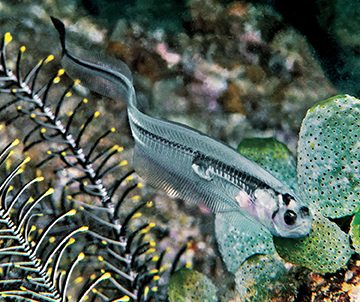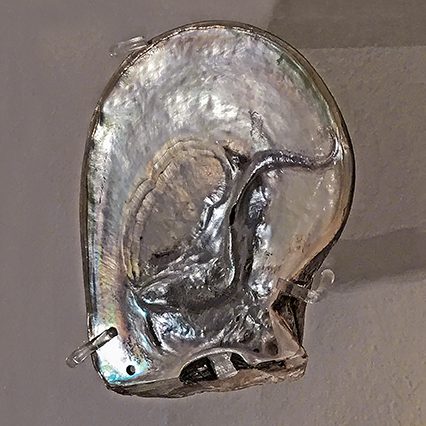UNTUK MENEMUKAN DESKRIPSI PERTAMA DARI LARVA IKAN MUTIARA in the wild, I had to search back to the early 1980s annals of blackwater diving and Christopher Newbert’s account of drifting 40 feet (12 meters) down a lighted downline tethered to a dinghy bobbing on a night sea somewhere off the Kona, Hawaiʻi, coast. The story appeared in Di Dalam Laut Pelangi, Chris’ 1984 coffee-table classic that transformed underwater photography and, within the same pages, introduced readers to breathtaking images of never-before-seen fish larvae in the open sea.
In the passage, Chris wrote, “My eye caught the sight of a long, thin, ribbonlike fish hanging nearly stationary…I was mesmerized by the narrow filament protruding from the base of its head and stretching upward in equal measure to the eighteen-inch length of its body…We stared at each other for a time, and then, its curiosity apparently satisfied, it began to swim away…backward.” Chris’ awe was not misplaced. Over the decades the conspicuously large and lacy larval pearlfish have been frequent and welcome visitors to the bright lights of blackwater activities in tropical waters around the world.
Our first encounters with the fabled larvae occurred during a night drift off Palm Beach, Florida. After the shock of finding the unexpected treasure, what struck us was how cleverly the larva’s translucent, spaghetti-thin body and filament mimicked streaming strands of stinging tentacles trailing behind jellyfishes and siphonophores.

NED DAN ANNA DELOACH
Mimicry is hard to prove. But the recent influx of blackwater imagery argues that numerous fish larvae, particularly deepwater species, acquire some immunity from predation by resembling common venomous sea creatures. To our delight, these unintended byproducts of natural selection engender many of the most flamboyant morphological adaptations in the ocean — just the sort of ultra-animals we adore.
In addition to their larger size, pearlfish differ from other oceanic larvae in several ways. Unlike most larvae that shy away from bright lights, pearlfish are attracted to our downlines, where they feed in the glow. Close-up images revealed another surprise: The larva’s entire digestive system, including the anus, is packed inside a small protrusion beneath and slightly behind its head.
Larval pearlfish go through two distinct phases during the roughly three months they spend in that form, sojourning in the pelagic — a protracted voyage compared with the brief two- to four-week schedule of most reef-related species. Body length plays an interesting role in their transition into bottom-dwelling adults. What looked like an 18-inch (46 centimeters) body to Chris was likely shorter than his estimate. But Chris can be excused — remember, he had just encountered a giant more than 20 times longer than typical fish larvae.
Pada awal fase pertumbuhan kedua, sirip punggung depan yang memanjang menghilang, dan ekornya mulai memanjang sebagai persiapan untuk hidup di dasar laut. Di sinilah cerita berubah secara tidak terduga. Selama menetap, larva mutiara Atlantik (Carapus bermudensis) harus menemukan inang tertentu atau mati. Dalam hal ini, mereka menyembunyikan diri di dalam rongga tubuh pemulung penyaring kotoran yang keriput, berbentuk sosis, yang dikenal sebagai teripang bergigi lima (Actinopyga agassizii) selama sisa hidup mereka yang kurang lebih tiga tahun. Pengungsi yang masih muda dan ramping berukuran 10 inci (25 cm) ini harus menunggu saat yang tepat bagi inang untuk mengendurkan sfingternya saat bernapas, sebelum menggeliat ke belakang. Seperti yang mungkin sudah Anda duga, selain mulut, hanya ada satu lubang yang mengarah ke inang di ujung belakang, di mana pita berpasir dari kotoran keluar seperti pasta gigi.
Over the first few weeks, the larva shrinks to one-third of its settlement size before growing once again into what will eventually be a 6- to 10-inch (15 to 25 centimeters), transparent, letter-opener-shaped adult that only dares to venture out of its symbiotic home to forage for crustaceans after dark. As we read later, a group of researchers theorized that the unconventional anterior location of the larva’s alimentary canal is a modification allowing adults to relieve themselves outside their host without exposing their entire body
terhadap bahaya.
Only a few of the 37 species of pearlfish reside inside sea cucumbers; others prefer sea stars or live free of hosts, although the majority favor oysters. This preference leads to the origin of the pearlfish’s common name, likely bestowed by oyster shuckers harvesting pearls long ago. In response to parasites such as sponges that bore holdfasts into their shells, pearl oysters lay down a glistening coating of mother-of-pearl to seal out the intruders. The rarest of all pearls is not necessarily uniformly round with even layers of luster, as one would think, but instead, a “fish pearl” — an entombed pearlfish on the half-shell graced with a covering of nacre following death inside its symbiotic home.

NED DAN ANNA DELOACH
JELAJAH LEBIH LANJUT
Pelajari lebih lanjut tentang ikan mutiara dalam video ini.
© Alert Diver — Q4 2022